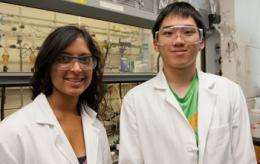Making stem-cell band-aids for the retina

At the beginning of July, Caltech senior Wilson Ho found himself hiking, stargazing, and camping in Yosemite National Park with a Nobel laureate. He even joined a group of scientists for a spontaneous jump into a freezing cold stream.
Ho was spending the summer working on a SURF project in the lab of Robert Grubbs, one of the winners of the 2005 Nobel Prize in Chemistry. Therefore, he had earned himself a spot on the Grubbs team's annual camping trip.
"It feels pretty surreal sometimes," Ho says, not just of spending five days camping with Grubbs, the Victor and Elizabeth Atkins Professor of Chemistry, but also of getting the opportunity to work for the esteemed researcher. "The experience has been exactly what I was hoping for."
Ho, a chemistry major, originally contacted Grubbs in January, searching for a summer research project that dealt with catalysis or organometallic chemistry, the study of chemical compounds that contain carbon atoms bound to metals. Grubbs told him that postdoctoral scholar Paresma Patel was looking for an intern to help with a chemical-synthesis project related to macular degeneration—a disease that is associated with aging and causes cells in a part of the retina to die. Macular degeneration is estimated to affect 1.8 million Americans, with another 7.3 million at substantial risk of developing the disease. Patel's project, funded by the California Institute for Regenerative Medicine, sounded so interesting that Ho signed up.
Ho, 21, tells his nonscientist friends and family that the goal of his project is to develop "stem-cell Band-Aids." The idea is that retinal cells, derived from human embryonic stem cells (or hESC-RPE cells), would be attached to the "Band-Aids." Eventually, the strips could be surgically applied to damaged retinas, holding new cells in place long enough to be incorporated into the eye and to restore vision.
"You might think that you could just stick stem cells in the eye and have them work," Ho says. "But it doesn't work that way because the new cells need to be held on top of the damaged tissue for some time."
What Ho is really doing is trying to coat a thin film of a bio-inert polymer called parylene with something that will encourage retinal cells to latch on. That something is a matrix containing peptides with a repeating arginine-glycine-aspartic acid amino-acid sequence, called RGD peptides.
Previous research has shown that RGD peptides bind to certain receptors expressed in hESC-RPE cells. Patel and Ho felt that the cells might bind better to a multilayered matrix containing RGD peptides, rather than just a single layer. So Ho spent much of the summer designing and carrying out a series of chemical reactions to create such a matrix.
Now that Ho has worked out how to synthesize the matrix, he's trying to figure out a way to get it to coat the parylene film. "Making one thing stick onto another that is prized for its inertness is obviously going to be a little bit difficult," Ho says with a chuckle. But he has plenty of ideas about how to try to make that happen, and he has already started testing them.
Those problem-solving skills, combined with Ho's attention to detail and his enthusiasm for the project, have impressed Patel. "Wilson surpassed the goals set out for him over the summer and will continue doing research in the Grubbs lab throughout the academic year," she says.
For his part, Ho says that he's looking forward to starting his senior year but that he truly enjoyed his SURF experience. "I love learning and being in the lab around such incredibly brilliant people—Grubbs himself, and really everyone in the lab," he says. "I've learned so much from all of them."















